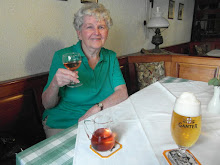
The village of Ettenheimmünster is nestled at the edge of the Schwarzwald, the world famous Black Forest. This village was formerly a Kur Ort or health resort, and in earlier days it was the end of the train line. The road also stopped here; to go over the mountain one had to use horses. At Münchweier, the town one kilometer west of us, the vineyards end, with the hills and mountains beginning at our doorstep.
The main street of Ettenheimmünster leads directly to France westward (through Münchweier)--without a turn either left or right. Twenty minutes later, at the end of that main road, one arrives at the Rhine River and the small ferry that crosses over to Alsace every 15 minutes each day. It is free and garners a lot of traffic to and fro.
If we drive out of our town eastwards, at the end of our village we immediately climb the first mountain--the Streitberg. Once over the top and down again on the other side one comes to the Schutter Valley with beautiful views of meadows, farms and cattle grazing. Turn left, you will find many towns as well as many Gasthäuser. Turn right at that junction and you head into the high hills and another mountain to some lovely villages.
Our village, Ettenheimmünster, is also picturesquely located. It is mainly residential. An artisan makes and sells pottery at the bottom of our street and just above by the canal is an Imker or bee-keeper. A large long-term care home, recently renovated and in the old style, sits on former monastery land on the main street through town. That monastery is now long gone except for part of the wall. Until recently, within the walls, were a flour mill and baker. There is a small business that sells fireplaces on the main street now celebrating its 25th year.
Just below the pottery maker, on the corner facing the church, is a cafe. Here in Germany cafes are known for their coffee and cake rather than a place where townspeople congregate to drink wine and have discussions or perhaps have a small bite to eat as in France. However, cafes here do offer small meals, wine and beer and they can be a meeting place. Our cafe is small and not fancy, but it has fresh Brötchen (rolls), tortes and cakes every day and offers a few other simple things to eat. In summer, there are tables and chairs outside beside the sidewalk. As the cafe is directly across the street from the cathedral, many tourists stop by throughout the year.
The cathedral, Wahlfahrtskirche St. Landolin, a pilgrimage church in the baroque style, is the most important site in our village. The church of today was built in 1687. It contains one of the few Silbermann organs in the world, built between 1766 and 1769. The church's history, baroque interior, and its famous organ attract visitors from all over Europe and elsewhere. Concerts throughout the year fill the church to overflowing.
Part of the lore of the church is the natural spring well that is sheltered under a cupola next to the main door. The story is that an Irish monk came to what is now Ettenheimmünster. A heathen hunter is said to have murdered him by beheading and where the monk's head fell onto the ground, five Quellen or springs arose. He became a martyr. This led to many other monks coming to experience this wonder. By 725 stood the first settlement for monks and, later, a large monastery was built. The waters are supposed to be good for the eyes. The story of the beheading and the springs can be seen on the ceiling of the church.
Across the street from the church, near the cafe, is another spring well and every day people line up to fill their containers with the water: not for their eyes but for their coffee!
Unfortunately we have no Gasthaus in our village. One that closed its door as a Gasthaus now makes and sells Flammen Kuchen--a specialty of this region--to various Gasthäuser and markets and for parties. Flammen Kuchen (called tarte flambe in France) has a thin pastry-type crust and various toppings; my favourite is the topping with Münsterkäse (Munster cheese). Schinken (slightly smoked ham) is a common topping. First though, a mixture of sour cream, eggs and creme fraiche is spread over the pastry. That might change somewhat with the baker. You will find it at every festival or special market.
From our house we hear the church steeple clock announcing the time every quarter hour. Last spring the steeple was struck by lightening and it damaged the clock and the bells. It took a few days for the repair and I must say everyone missed both. We also hear the church bells pealing out whenever there is a wedding, a funeral or a service. The biggest day, though, is on December 31st at midnight, when, along with bells from all the churches in the whole area and throughout Germany, they ring in the New Year for several minutes, accompanied by fireworks from every single village and town.


Admiring the time and effort you put into your website and detail
ReplyDeleteby detail information you present.
My weblog Motorcycle News
This is really interesting, You are a very skilled blogger.
ReplyDeleteI've joined your rss feed and look forward to seeking more of your magnificent post. Also, I've shared
your website in my social networks!
Feel free to visit my weblog ... tv.goldmineradio.com